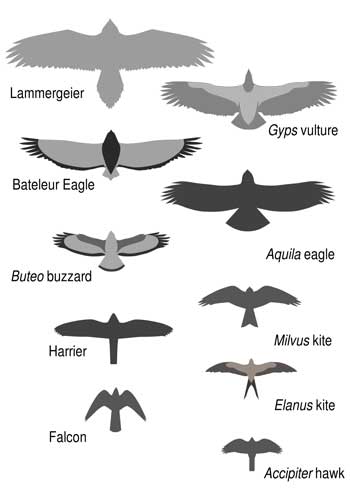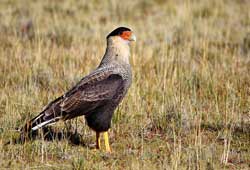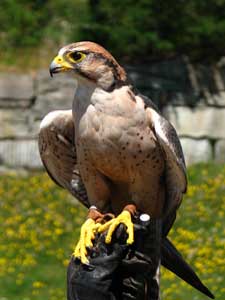Birds of prey are birds that hunt for food primarily via flight, using their keen senses, especially vision. They are defined as birds that primarily hunt vertebrates, including other birds. Their talons and beaks tend to be relatively large, powerful and adapted for tearing flesh. In most cases, the females are considerably larger than the males. The term “raptor” is derived from the Latin word rapere (meaning to seize or take by force) and may refer informally to all birds of prey, or specifically to the diurnal group. Because of their predatory lifestyle, often at the top of the food chain, they face distinct conservation concerns.
Many species of bird may be considered partly or exclusively predatory; however, in ornithology the term “bird of prey” applies only to birds of the families listed below.

The common names for various birds of prey are based on structure but many of the traditional names do not reflect the evolutionary relationships between the groups (Image Courtesy of Shyamal)
Taken literally the term “bird of prey” has a wide meaning that includes many birds that hunt and feed on animals and also birds that eat very small insects. In ornithology, and the definition used here, the term has a narrower meaning for birds that have very good eyesight for finding food, strong feet for holding food, and a strong curved beak for tearing flesh. Most birds of prey also have strong curved talons for catching or killing prey. Birds of prey generally prey on vertebrates, which are usually quite large relative to the size of the bird. Most also eat carrion at least occasionally and the vultures and condors eat carrion as their main food source. By way of an example, the narrower definition excludes storks and gulls, which can eat quite large fish, partly because these birds catch and kill prey entirely with their beaks, and similarly bird-eating skuas, fish-eating penguins, and vertebrate-eating kookaburras are excluded.

Using this cluster of anatomical and behavioural features, the species listed below are usually known to be birds of prey in ornithology. They can be divided into species that hunt during daylight, the raptors, and into species that hunt during the night, the owls. The raptors and the owls are distantly related and are classified in separate orders; however, their evolution has been convergent, both groups of birds adapting to a predatory lifestyle.
The successful and now widespread captive breeding of birds of prey began as a response to dwindling wild populations due to persistent toxins such as PCBs and DDT, systematic persecution as undesirable predators, habitat loss, and the resulting limited availability of popular species for falconry, particularly the peregrine falcon. The first known raptors to breed in captivity belonged to a German falconer named Renz Waller. In 1942–1943 he produced two young peregrines in Düsseldorf in Germany.
The first successful captive breeding of peregrine falcons in North America occurred in the early 1970s by The Peregrine Fund, Professor and falconer Heinz Meng, and other private falconer/breeders such as David Jamieson and Les Boyd who bred the first peregrines by means of artificial insemination. In Great Britain, falconer Phillip Glasier of the Falconry Centre in Newent, Gloucestershire, was successful in obtaining young from more than 20 species of captive raptors. A cooperative effort began between various government agencies, non-government organizations, and falconers to supplement various wild raptor populations in peril. This effort was strongest in North America where significant private donations along with funding allocations through the Endangered Species Act of 1972 provided the means to continue the release of captive-bred Peregrines, Golden Eagles, Bald Eagles, Aplomado Falcons and others. By the mid-1980s, falconers had become self-sufficient as regards sources of birds to train and fly, in addition to the immensely important conservation benefits conferred by captive breeding.
Between 1972 and 2001, nearly all Peregrines used for falconry in the U.S. were captive-bred from the progeny of falcons taken before the U. S. Endangered Species Act was enacted and from those few infusions of wild genes available from Canada and special circumstances. Peregrine Falcons were removed from the United States’ endangered species list on August 25th, 1999. Finally, after years of close work with the US Fish and Wildlife Service, a limited take of wild Peregrines was allowed in 2001, the first wild Peregrines taken specifically for falconry in over 30 years.

Some controversy has existed over the origins of captive breeding stock used by The Peregrine Fund in the recovery of peregrine falcons throughout the contiguous United States. Several peregrine subspecies were included in the breeding stock, including birds of Eurasian origin. Due to the extirpation of the Eastern anatum (Falco peregrinus anatum), the near extirpation of the anatum in the Midwest, and the limited gene pool within North American breeding stock, the inclusion of non-native subspecies was justified to optimize the genetic diversity found within the species as a whole. Such strategies are common in endangered species re-introduction scenarios, where dramatic population declines result in a genetic bottleneck and the loss of genetic diversity.
Laws regulating the capture and import/export of wild falcons throughout the Middle East and Asia vary, and the effective enforcement of existing national and international regulations are lacking in some regions. The proliferation of captive-bred falcons into the falcon markets of the Arabian Peninsula has likely moderated this demand for wild falcons.
The species within the genus Falco are closely related and some pairings produce viable offspring. The heavy northern Gyrfalcon and Asiatic Saker being especially closely related, and it is not known whether the Altai Falcon is a subspecies of the Saker or descendants of naturally occurring hybrids. Peregrine and prairie falcons have been observed breeding in the wild and have produced offspring. These pairings are thought to be rare, however extra-pair copulations between closely related species may occur more frequently and/or account for most natural occurring hybridization. Some male first generation hybrids may have viable sperm, whereas very few first generation female hybrids lay fertile eggs. Because of these factors, naturally occurring hybridization is thought to be somewhat insignificant to gene flow in raptor species.
The first hybrid falcons produced in captivity occurred in western Ireland when veteran falconer Ronald Stevens and the Hon. John Morris put a male saker and a female peregrine into the same moulting mews for the spring and early summer, and the two mated and produced offspring.
Captively bred hybrid falcons have been available since the late 1970s, and enjoyed a meteoric rise in popularity in North America and the UK in the 1990s. Hybrids were initially “created” to combine the horizontal speed and size of the gyrfalcon with the good disposition and aerial ability of the peregrine. Hybrid falcons first gained large popularity throughout the Arabian Peninsula, feeding a demand for particularly large and aggressive female falcons capable and willing to take on the very large Houbara Bustard, the classic falconry quarry in the deserts of the Middle East. These falcons were also very popular with Arab falconers as they tended to withstand a respiratory disease (aspergillosis from the mold strain aspergillus) in stressful desert conditions better than other pure species from the northern hemisphere.
Wings Over Colorado LLC
Phone: (720) 425-8968
Email @ rob@wingsovercolorado.com
Copyright © 2012 Wings Over Colorado. All Rights Reserved. Top ↑